Sheet Rubber
SBR Rubber
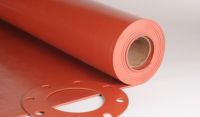
SBR is the most widely used synthetic rubber. It has good aging, abrasion, and tear resistant properties. This is a smooth plate finish sheet. Red Rubber is good for use in low pressure steam applications, hot and cold water, and air. Avoid using this sheet in oil applications, as it has no oil resistance.
Neoprene Rubber
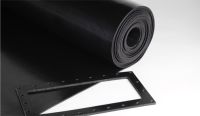
Neoprene compound with low temperature flexibility and oil resistance. This rubber is chemically inert and resists rotting, checking and cracking due to weather exposure. This is a smooth plate finish sheet utilizing a high quality neoprene blend.
Cloth Inserted Neoprene
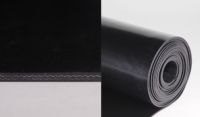
CI Neoprene is a medium grade neoprene compound with one or more polyester fabric plies, for service where dimensional stability is required. Fabric content is one ply for 1/32” and 1/16”, two plies for 1/8”, three plies for 3/16”, and four plies for ¼” thick. This is a smooth plate finish sheet manufactured from a Neoprene based Compound. Cloth Inserted Neoprene rubbers are good for use in oil, hot or cold water, and gas applications.
Neoprene rubbers are good for use in oils, water, and oxidation. Neoprene can be manufactured in numerous different durometer ratings. Please call with your specific requirements.
Cloth Inserted SBR
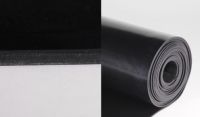
Cloth Inserted SBR is an SBR compound rubber reinforced with a close weave polyester fabric. This construction included one ply of fabric for each 1/16” thickness. Cloth reinforcement enhances dimensional stability in flanged gasket applications with high compression loads. This is a smooth plate finish sheet manufactured from a SBR based Compound.
Cloth Inserted SBR rubbers are good for use in air, hot water, saturated steam, low pressure steam, and hydraulic applications. Avoid using this sheet in oil applications, as it has no oil resistance.
Neoprene Diaphragm Sheet
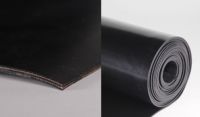
Neoprene Diaphragm Sheet is an oil resistant neoprene blended sheet reinforced with polyester fabric. It is capable of permitting relative motion between a stationary and a moving member while maintaining a separation of the two media on either side and may maintain a pressure differential between the two media. This is a smooth plate finish sheet manufactured from superior components and properties for long service life.
Neoprene Diaphragm rubbers are good for use in oils, gases, and air in gauges, meters, and valves. This material also makes for an excellent weather stripping material.
*It should be careful assessed for suitability to assure low permeability to the fluids or gases it will separate.
EPDM RUBBER
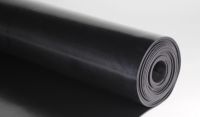
EPDM or Ethylene-propylenediene rubber terpolymer provides superior properties for outdoor and high temperature applications. It has good chemical and electrical properties and resists animal and vegetable oils, ozone, sunlight, and oxygenated solvents. This is manufactured to a smooth plate finish. Also available in Peroxide Cured for increased tensile strength and higher temperature ratings.
The material provides excellent resistance to heat, cold, oxidation, steam, water, and ultraviolet light. EPDM also has excellent resistance to phosphate ester hydraulic fluids and polar solvents like MEK and acetone.
EPDM rubber should be avoided being used with mineral products (oils, greases, and fuels).
Gum Rubber
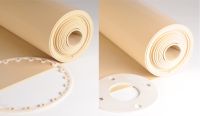
Pure Gum Rubber is a full floating natural rubber. Style 449 is manufactured from pure Gum Rubber to form a smooth resilient sheet.
Gum Rubber has superior resilience, tensile, elongation, and abrasion resistance properties. It has excellent tear strength, is resistant to water, most salts, mild acids, and many other chemicals, and is non-marking and non-toxic.
Examples of conditions where the use of Gum Rubber should be avoided are: environments involving ozone, strong acids, animal fats, oils, greases, and most hydrocarbons.
Silicone Rubber
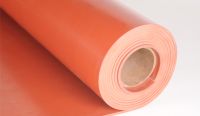
Silicone rubber is a material containing carbon, hydrogen, and oxygen. Silicone rubber is generally non-reactive, stable, and resistant to extreme environments and temperatures.
Silicone Rubber is used in applications where physical properties are not critical but extreme temperature resistance is necessary. This rubber possesses the most resistance to high temperature of all rubber sheets, has great UV and ozone resistance, and excellent resistance to Fungus, Acetic Acid, Ammonia Gas (hot and cold), oils, Lime Sulfur, Methyl Ether, and Sodium Sulfate.
Nitrile rubber (NBR) or Buna N
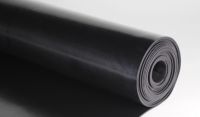
Nitrile rubber (NBR) or Buna N is the general term for acrylonitrile butadiene copolymer. The acrylonitrile content of nitrile sealing compounds varies considerably (18% to 50%) and influences the physical properties of the finished material. The higher the acrylonitrile content, the better the resistance to oil and fuel. At the same time, elasticity and resistance to compression set is adversely affected. In view of these opposing realities, a compromise is often drawn, and a medium acrylonitrile content selected. Style 480 is a smooth plate finish sheet manufactured from a Nitrile based Compound.
Buna N rubbers have good oil and gasoline resistance, tensile strength, elongation properties, heat resistance, and low compression set. This rubber works well on many acids, petroleum, mineral and vegetable oils.
Examples of conditions where the use of Buna N should be avoided are: Fuels of high aromatic content, aromatic and chlorinated hydrocarbons, ketone, acetone, acetic acid, ethylene-ester, strong acids, brake fluids, and ozone, weather and atmospheric aging environments.
Viton® Fluorocarbon rubber (FKM)

Viton® Fluorocarbon rubber (FKM) or Fluoroelastomer was originally developed in 1957 by DuPont® as an answer to high temperature applications that also can resist chemical attack.
The material provides good sealing qualities in applications requiring resistance to temperature, weathering, and gas permeability. This unique product stands up to ozone, fuels, aliphatic hydrocarbons, aromatic hydrocarbons, lubricants, organic solvents, certain acids, and many corrosive industrial applications.
Examples of conditions where the use of Fluorocarbon rubber should be avoided are: ketones, low molecular weight organic acids, superheated steam, and glycol based fluids.
Hypalon

Hypalon is a trademark for chlorosulfonated synthetic rubber (CSM) originally developed by DuPont® as an answer for its resistance to chemicals, temperature extremes, and ultraviolet light.
Hypalon is one of the most weather-resistant elastomers available as the rubber material demonstrates almost complete resistance to UV/ozone and will not degrade in long-term sunlight exposure. This rubber also has excellent resistance to abrasion, outstanding resistance to most chemicals, oils and acids, good dielectric strength, and low moisture absorption.
